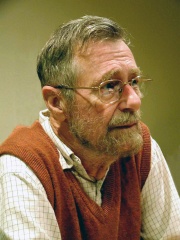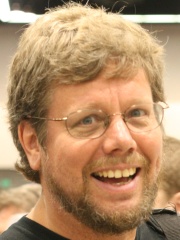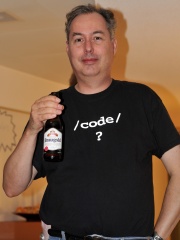



The Most Famous
COMPUTER SCIENTISTS from Netherlands
This page contains a list of the greatest Dutch Computer Scientists. The pantheon dataset contains 245 Computer Scientists, 4 of which were born in Netherlands. This makes Netherlands the birth place of the 9th most number of Computer Scientists behind Israel, and Japan.
Top 4
The following people are considered by Pantheon to be the most legendary Dutch Computer Scientists of all time. This list of famous Dutch Computer Scientists is sorted by HPI (Historical Popularity Index), a metric that aggregates information on a biography's online popularity.

1. Edsger W. Dijkstra (1930 - 2002)
With an HPI of 70.14, Edsger W. Dijkstra is the most famous Dutch Computer Scientist. His biography has been translated into 61 different languages on wikipedia.
Edsger Wybe Dijkstra ( DYKE-strə; Dutch: [ˈɛtsxər ˈʋibə ˈdɛikstraː] ; 11 May 1930 – 6 August 2002) was a Dutch computer scientist, programmer, mathematician, and science essayist. Born in Rotterdam in the Netherlands, Dijkstra studied mathematics and physics and then theoretical physics at the University of Leiden. Adriaan van Wijngaarden offered him a job as the first computer programmer in the Netherlands at the Mathematical Centre in Amsterdam, where he worked from 1952 until 1962. He formulated and solved the shortest path problem in 1956, and in 1960 developed the first compiler for the programming language ALGOL 60 in conjunction with colleague Jaap A. Zonneveld. In 1962 he moved to Eindhoven, and later to Nuenen, where he became a professor in the Mathematics Department at the Technische Hogeschool Eindhoven. In the late 1960s he built the THE multiprogramming system, which influenced the designs of subsequent systems through its use of software-based paged virtual memory. Dijkstra joined Burroughs Corporation as its sole research fellow in August 1973. The Burroughs years saw him at his most prolific in output of research articles. He wrote nearly 500 documents in the "EWD" series, most of them technical reports, for private circulation within a select group. Dijkstra accepted the Schlumberger Centennial Chair in the Computer Science Department at the University of Texas at Austin in 1984, working in Austin, USA, until his retirement in November 1999. He and his wife returned from Austin to his original house in Nuenen, where he died on 6 August 2002 after a long struggle with cancer. He received the 1972 ACM Turing Award for fundamental contributions to developing structured programming languages. Shortly before his death, he received the ACM PODC Influential Paper Award in distributed computing for his work on self-stabilization of program computation. This annual award was renamed the Dijkstra Prize the following year, in his honor.

2. Guido van Rossum (b. 1956)
With an HPI of 64.73, Guido van Rossum is the 2nd most famous Dutch Computer Scientist. His biography has been translated into 51 different languages.
Guido van Rossum (Dutch: [ˈxidoː vɑn ˈrɔsʏm]; born 31 January 1956) is a Dutch programmer. He is the creator of the Python programming language, for which he was the "benevolent dictator for life" (BDFL) until he stepped down from the position on 12 July 2018. He remained a member of the Python Steering Council through 2019, and withdrew from nominations for the 2020 election.

3. Bram Moolenaar (1961 - 2023)
With an HPI of 47.80, Bram Moolenaar is the 3rd most famous Dutch Computer Scientist. His biography has been translated into 23 different languages.
Bram Moolenaar (Dutch: [brɑ‿ˈmoːlənaːr]; 1961 – 3 August 2023) was a Dutch software engineer and activist who was the creator, maintainer, and benevolent dictator for life of Vim, a vi-derivative text editor. He advocated for ICCF Holland, a non-governmental organization supporting AIDS victims in Uganda, and used the popularity of Vim to encourage donations. From July 2006 until September 2021, Moolenaar was employed by Google, working in the Zürich office on Google Calendar. He spent part of his time maintaining Vim.

4. Mark Overmars (b. 1958)
With an HPI of 43.01, Mark Overmars is the 4th most famous Dutch Computer Scientist. His biography has been translated into 15 different languages.
Markus Hendrik "Mark" Overmars (Dutch pronunciation: [ˈmɑrkʏs ˈɦɛndrɪk ˈmɑr(ə)k ˈoːvərmɑrs]; born 29 September 1958) is a Dutch computer scientist and teacher of game programming known for his game development application GameMaker. GameMaker allows users to create computer games using a drag-and-drop interface. He is the former head of the Center for Geometry, Imaging, and Virtual Environments at Utrecht University in the Netherlands. This research center focuses on computational geometry and its applications in areas such as computer graphics, robotics, geographic information systems, imaging, multimedia, virtual environments, and games. Overmars received his Ph.D. in 1983 from Utrecht University under the supervision of Jan van Leeuwen, and remained a faculty member at the same university until September 2013. Overmars has published over 100 journal papers, largely on computational geometry, and is a co-author of several widely used textbooks on the subject. Overmars has also worked in robotics. He was the first to develop the probabilistic roadmap method in 1992, which was later independently discovered by Kavraki and Latombe in 1994. Their joint paper, Probabilistic roadmaps for path planning in high-dimensional configuration spaces, is considered one of the most influential studies in motion planning, and has been widely cited (more than 2,500 times as of 2014, according to Google Scholar). In 2011, Overmars and game designer Jochem Schut developed a snake video game called Super Snake HD as a mobile app, which was published by YoYo Games. Overmars founded and served as the CTO of Tingly Games from 2012 until its acquisition by CoolGames in 2016. Tingly focused on HTML5 games and e-cards/casual games, the latter of which are also known as "greeting games." He founded Quarterfall in June 2020 together with Arjan Egges. Quarterfall is a teaching product that helps teachers use formative assessment to improve the learning processes their students, compared to just assessing their performance. He is also the original author of the XForms toolkit.
People
Pantheon has 4 people classified as Dutch computer scientists born between 1930 and 1961. Of these 4, 2 (50.00%) of them are still alive today. The most famous living Dutch computer scientists include Guido van Rossum, and Mark Overmars. The most famous deceased Dutch computer scientists include Edsger W. Dijkstra, and Bram Moolenaar.

